LAW 8500 Assignment 1: Fine Diamond Jewellery and Security Contract
VerifiedAdded on 2022/10/06
|7
|1808
|31
Homework Assignment
AI Summary
This assignment analyzes a business law case concerning Fine Diamond Jewellery and its contract with Transglobal Alarm Monitoring Pty Ltd for security services. The assignment addresses three key legal issues: the validity of an exclusion clause in the contract, the possibility of claiming compensation for losses due to a robbery resulting from a malfunctioning security system, and whether the security company can avoid liability using the exclusion clause. The solution applies legal principles, including those related to exclusion clauses, breach of contract, and foreseeability of damages, as established in cases like Hadley v Baxendale, to determine the rights and obligations of each party. The analysis follows the ILAC method, identifying the issues, relevant laws, applying the law to the facts, and concluding with the outcomes of the case. The assignment determines whether the security company is liable for the losses suffered by the jewellery shop.
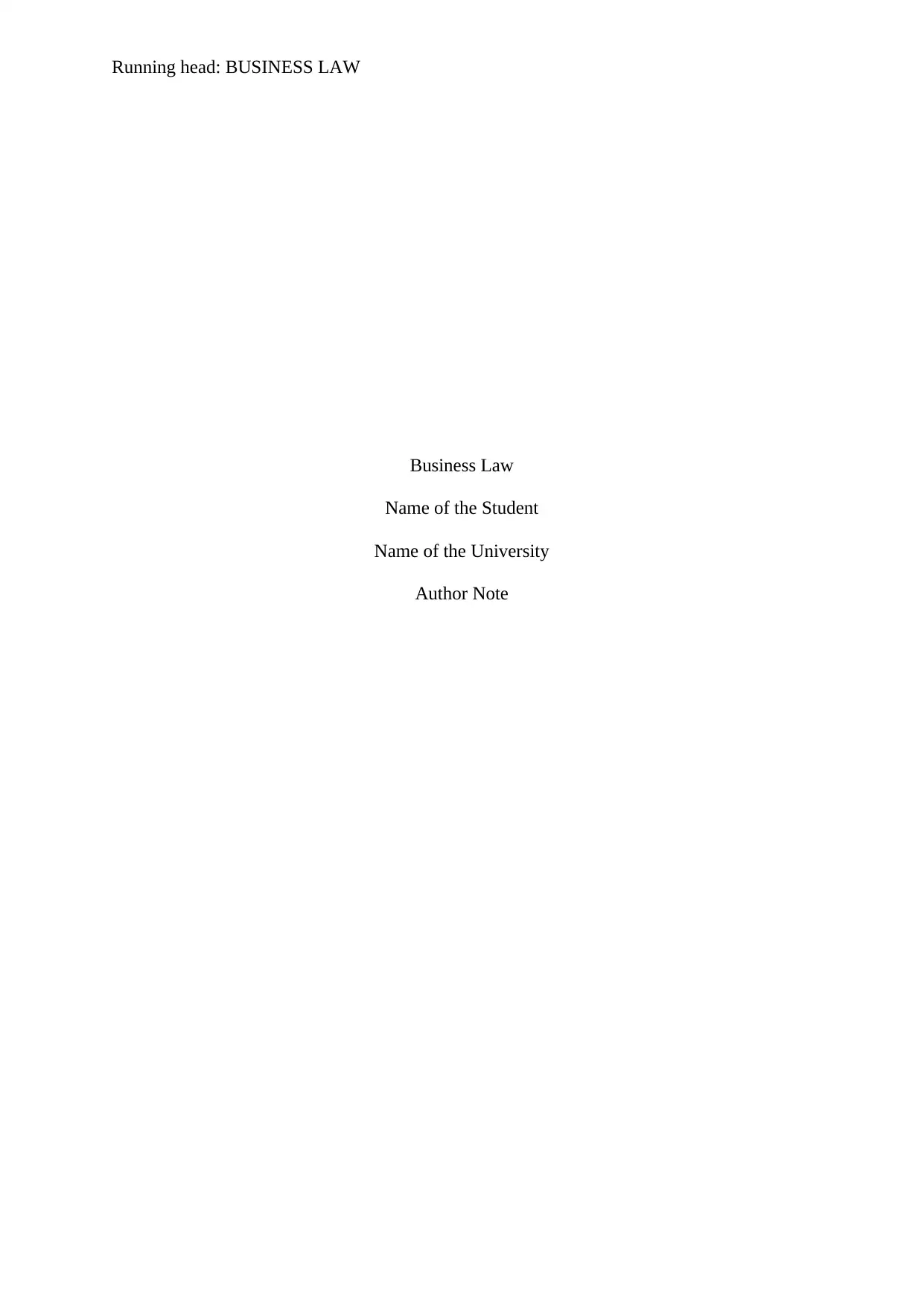
Running head: BUSINESS LAW
Business Law
Name of the Student
Name of the University
Author Note
Business Law
Name of the Student
Name of the University
Author Note
Paraphrase This Document
Need a fresh take? Get an instant paraphrase of this document with our AI Paraphraser
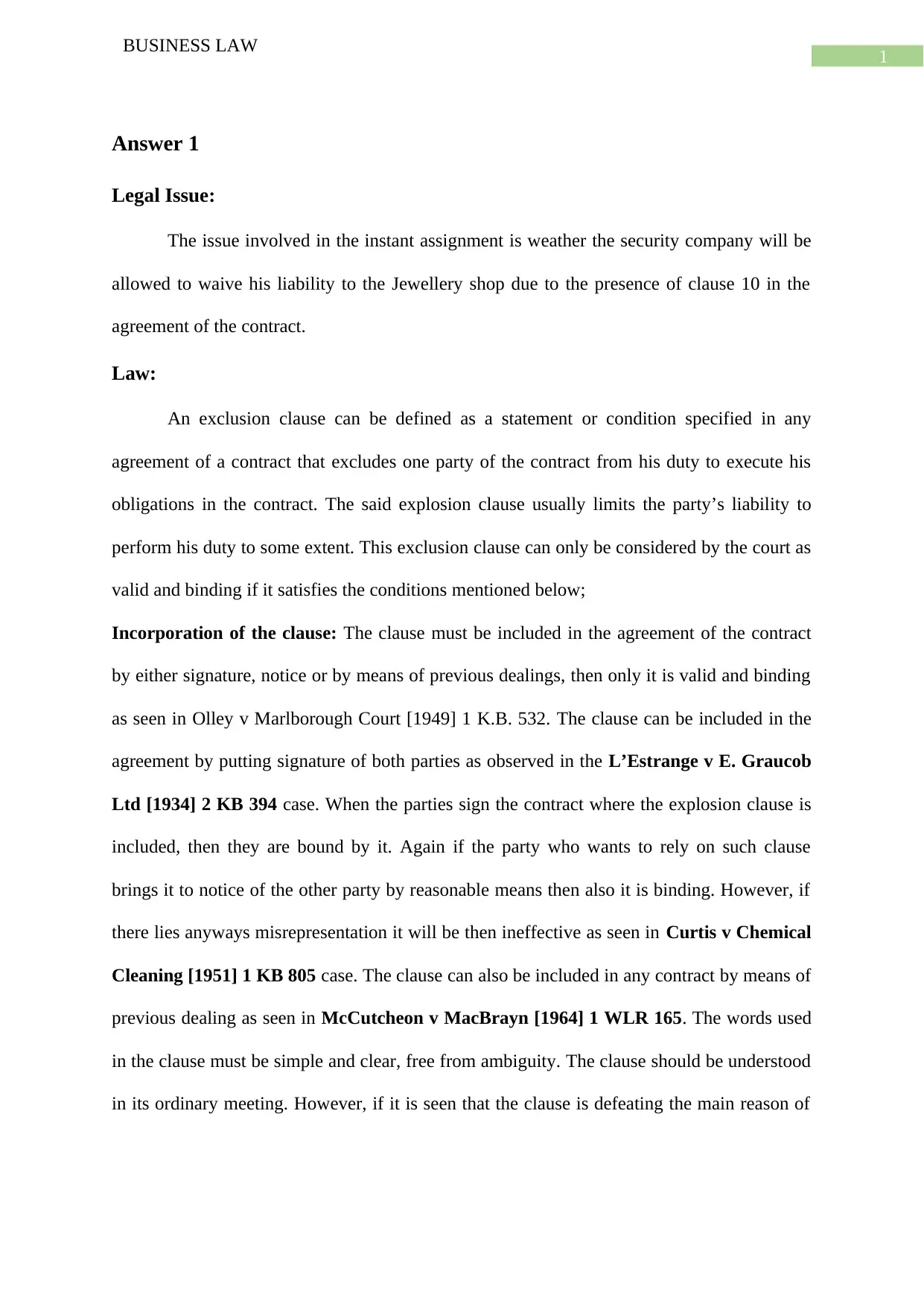
1
BUSINESS LAW
Answer 1
Legal Issue:
The issue involved in the instant assignment is weather the security company will be
allowed to waive his liability to the Jewellery shop due to the presence of clause 10 in the
agreement of the contract.
Law:
An exclusion clause can be defined as a statement or condition specified in any
agreement of a contract that excludes one party of the contract from his duty to execute his
obligations in the contract. The said explosion clause usually limits the party’s liability to
perform his duty to some extent. This exclusion clause can only be considered by the court as
valid and binding if it satisfies the conditions mentioned below;
Incorporation of the clause: The clause must be included in the agreement of the contract
by either signature, notice or by means of previous dealings, then only it is valid and binding
as seen in Olley v Marlborough Court [1949] 1 K.B. 532. The clause can be included in the
agreement by putting signature of both parties as observed in the L’Estrange v E. Graucob
Ltd [1934] 2 KB 394 case. When the parties sign the contract where the explosion clause is
included, then they are bound by it. Again if the party who wants to rely on such clause
brings it to notice of the other party by reasonable means then also it is binding. However, if
there lies anyways misrepresentation it will be then ineffective as seen in Curtis v Chemical
Cleaning [1951] 1 KB 805 case. The clause can also be included in any contract by means of
previous dealing as seen in McCutcheon v MacBrayn [1964] 1 WLR 165. The words used
in the clause must be simple and clear, free from ambiguity. The clause should be understood
in its ordinary meeting. However, if it is seen that the clause is defeating the main reason of
BUSINESS LAW
Answer 1
Legal Issue:
The issue involved in the instant assignment is weather the security company will be
allowed to waive his liability to the Jewellery shop due to the presence of clause 10 in the
agreement of the contract.
Law:
An exclusion clause can be defined as a statement or condition specified in any
agreement of a contract that excludes one party of the contract from his duty to execute his
obligations in the contract. The said explosion clause usually limits the party’s liability to
perform his duty to some extent. This exclusion clause can only be considered by the court as
valid and binding if it satisfies the conditions mentioned below;
Incorporation of the clause: The clause must be included in the agreement of the contract
by either signature, notice or by means of previous dealings, then only it is valid and binding
as seen in Olley v Marlborough Court [1949] 1 K.B. 532. The clause can be included in the
agreement by putting signature of both parties as observed in the L’Estrange v E. Graucob
Ltd [1934] 2 KB 394 case. When the parties sign the contract where the explosion clause is
included, then they are bound by it. Again if the party who wants to rely on such clause
brings it to notice of the other party by reasonable means then also it is binding. However, if
there lies anyways misrepresentation it will be then ineffective as seen in Curtis v Chemical
Cleaning [1951] 1 KB 805 case. The clause can also be included in any contract by means of
previous dealing as seen in McCutcheon v MacBrayn [1964] 1 WLR 165. The words used
in the clause must be simple and clear, free from ambiguity. The clause should be understood
in its ordinary meeting. However, if it is seen that the clause is defeating the main reason of
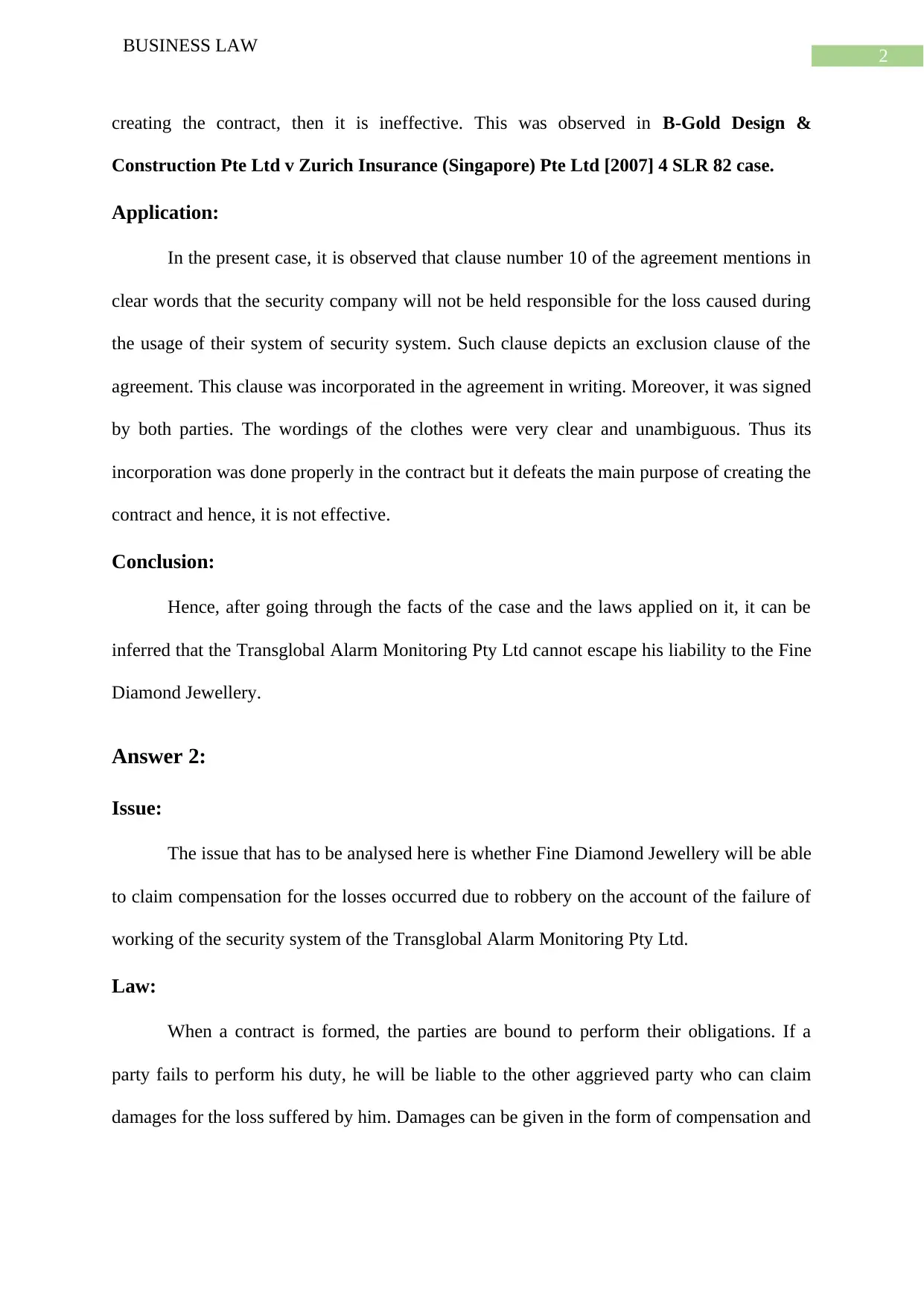
2
BUSINESS LAW
creating the contract, then it is ineffective. This was observed in B-Gold Design &
Construction Pte Ltd v Zurich Insurance (Singapore) Pte Ltd [2007] 4 SLR 82 case.
Application:
In the present case, it is observed that clause number 10 of the agreement mentions in
clear words that the security company will not be held responsible for the loss caused during
the usage of their system of security system. Such clause depicts an exclusion clause of the
agreement. This clause was incorporated in the agreement in writing. Moreover, it was signed
by both parties. The wordings of the clothes were very clear and unambiguous. Thus its
incorporation was done properly in the contract but it defeats the main purpose of creating the
contract and hence, it is not effective.
Conclusion:
Hence, after going through the facts of the case and the laws applied on it, it can be
inferred that the Transglobal Alarm Monitoring Pty Ltd cannot escape his liability to the Fine
Diamond Jewellery.
Answer 2:
Issue:
The issue that has to be analysed here is whether Fine Diamond Jewellery will be able
to claim compensation for the losses occurred due to robbery on the account of the failure of
working of the security system of the Transglobal Alarm Monitoring Pty Ltd.
Law:
When a contract is formed, the parties are bound to perform their obligations. If a
party fails to perform his duty, he will be liable to the other aggrieved party who can claim
damages for the loss suffered by him. Damages can be given in the form of compensation and
BUSINESS LAW
creating the contract, then it is ineffective. This was observed in B-Gold Design &
Construction Pte Ltd v Zurich Insurance (Singapore) Pte Ltd [2007] 4 SLR 82 case.
Application:
In the present case, it is observed that clause number 10 of the agreement mentions in
clear words that the security company will not be held responsible for the loss caused during
the usage of their system of security system. Such clause depicts an exclusion clause of the
agreement. This clause was incorporated in the agreement in writing. Moreover, it was signed
by both parties. The wordings of the clothes were very clear and unambiguous. Thus its
incorporation was done properly in the contract but it defeats the main purpose of creating the
contract and hence, it is not effective.
Conclusion:
Hence, after going through the facts of the case and the laws applied on it, it can be
inferred that the Transglobal Alarm Monitoring Pty Ltd cannot escape his liability to the Fine
Diamond Jewellery.
Answer 2:
Issue:
The issue that has to be analysed here is whether Fine Diamond Jewellery will be able
to claim compensation for the losses occurred due to robbery on the account of the failure of
working of the security system of the Transglobal Alarm Monitoring Pty Ltd.
Law:
When a contract is formed, the parties are bound to perform their obligations. If a
party fails to perform his duty, he will be liable to the other aggrieved party who can claim
damages for the loss suffered by him. Damages can be given in the form of compensation and
⊘ This is a preview!⊘
Do you want full access?
Subscribe today to unlock all pages.

Trusted by 1+ million students worldwide
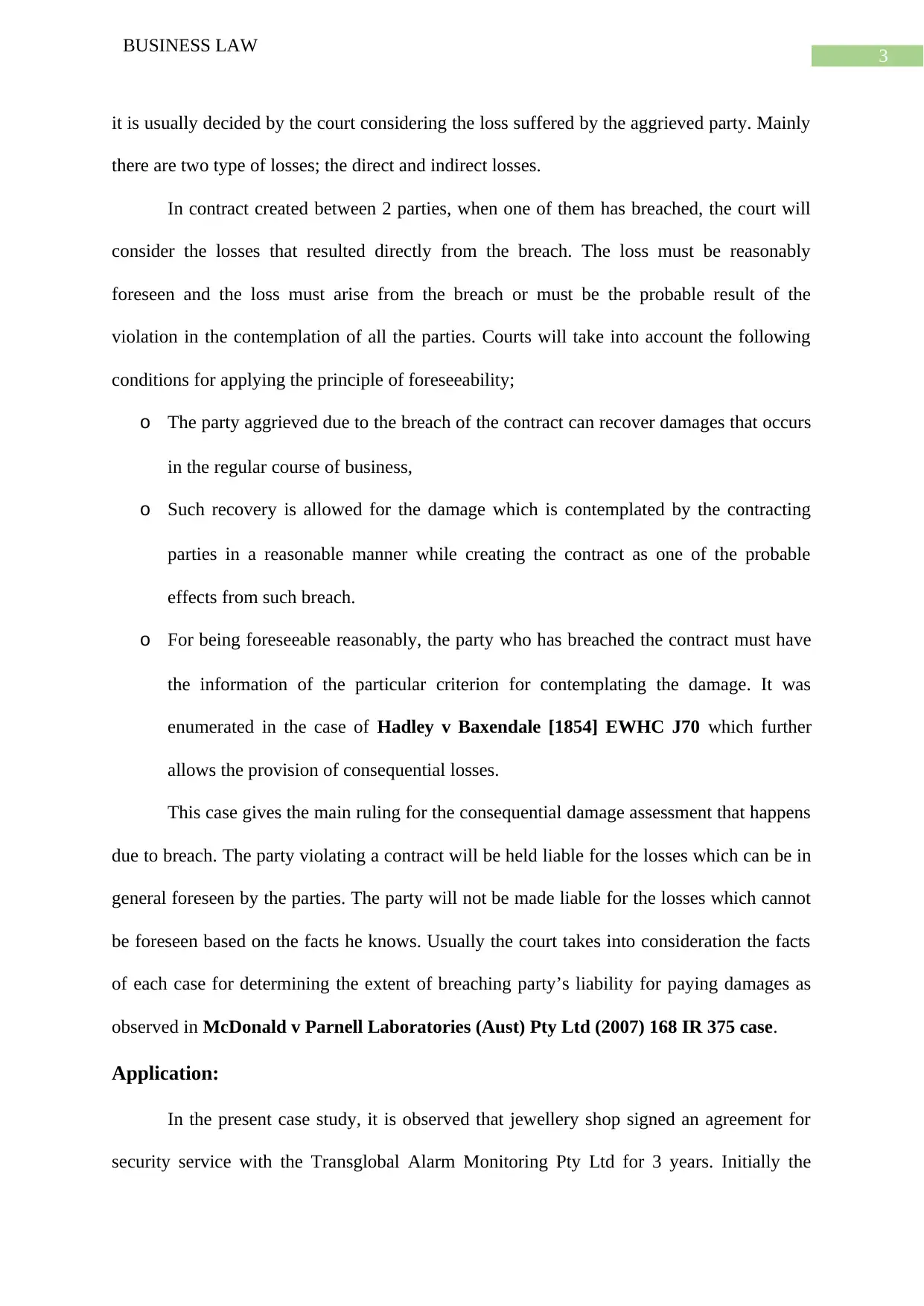
3
BUSINESS LAW
it is usually decided by the court considering the loss suffered by the aggrieved party. Mainly
there are two type of losses; the direct and indirect losses.
In contract created between 2 parties, when one of them has breached, the court will
consider the losses that resulted directly from the breach. The loss must be reasonably
foreseen and the loss must arise from the breach or must be the probable result of the
violation in the contemplation of all the parties. Courts will take into account the following
conditions for applying the principle of foreseeability;
o The party aggrieved due to the breach of the contract can recover damages that occurs
in the regular course of business,
o Such recovery is allowed for the damage which is contemplated by the contracting
parties in a reasonable manner while creating the contract as one of the probable
effects from such breach.
o For being foreseeable reasonably, the party who has breached the contract must have
the information of the particular criterion for contemplating the damage. It was
enumerated in the case of Hadley v Baxendale [1854] EWHC J70 which further
allows the provision of consequential losses.
This case gives the main ruling for the consequential damage assessment that happens
due to breach. The party violating a contract will be held liable for the losses which can be in
general foreseen by the parties. The party will not be made liable for the losses which cannot
be foreseen based on the facts he knows. Usually the court takes into consideration the facts
of each case for determining the extent of breaching party’s liability for paying damages as
observed in McDonald v Parnell Laboratories (Aust) Pty Ltd (2007) 168 IR 375 case.
Application:
In the present case study, it is observed that jewellery shop signed an agreement for
security service with the Transglobal Alarm Monitoring Pty Ltd for 3 years. Initially the
BUSINESS LAW
it is usually decided by the court considering the loss suffered by the aggrieved party. Mainly
there are two type of losses; the direct and indirect losses.
In contract created between 2 parties, when one of them has breached, the court will
consider the losses that resulted directly from the breach. The loss must be reasonably
foreseen and the loss must arise from the breach or must be the probable result of the
violation in the contemplation of all the parties. Courts will take into account the following
conditions for applying the principle of foreseeability;
o The party aggrieved due to the breach of the contract can recover damages that occurs
in the regular course of business,
o Such recovery is allowed for the damage which is contemplated by the contracting
parties in a reasonable manner while creating the contract as one of the probable
effects from such breach.
o For being foreseeable reasonably, the party who has breached the contract must have
the information of the particular criterion for contemplating the damage. It was
enumerated in the case of Hadley v Baxendale [1854] EWHC J70 which further
allows the provision of consequential losses.
This case gives the main ruling for the consequential damage assessment that happens
due to breach. The party violating a contract will be held liable for the losses which can be in
general foreseen by the parties. The party will not be made liable for the losses which cannot
be foreseen based on the facts he knows. Usually the court takes into consideration the facts
of each case for determining the extent of breaching party’s liability for paying damages as
observed in McDonald v Parnell Laboratories (Aust) Pty Ltd (2007) 168 IR 375 case.
Application:
In the present case study, it is observed that jewellery shop signed an agreement for
security service with the Transglobal Alarm Monitoring Pty Ltd for 3 years. Initially the
Paraphrase This Document
Need a fresh take? Get an instant paraphrase of this document with our AI Paraphraser
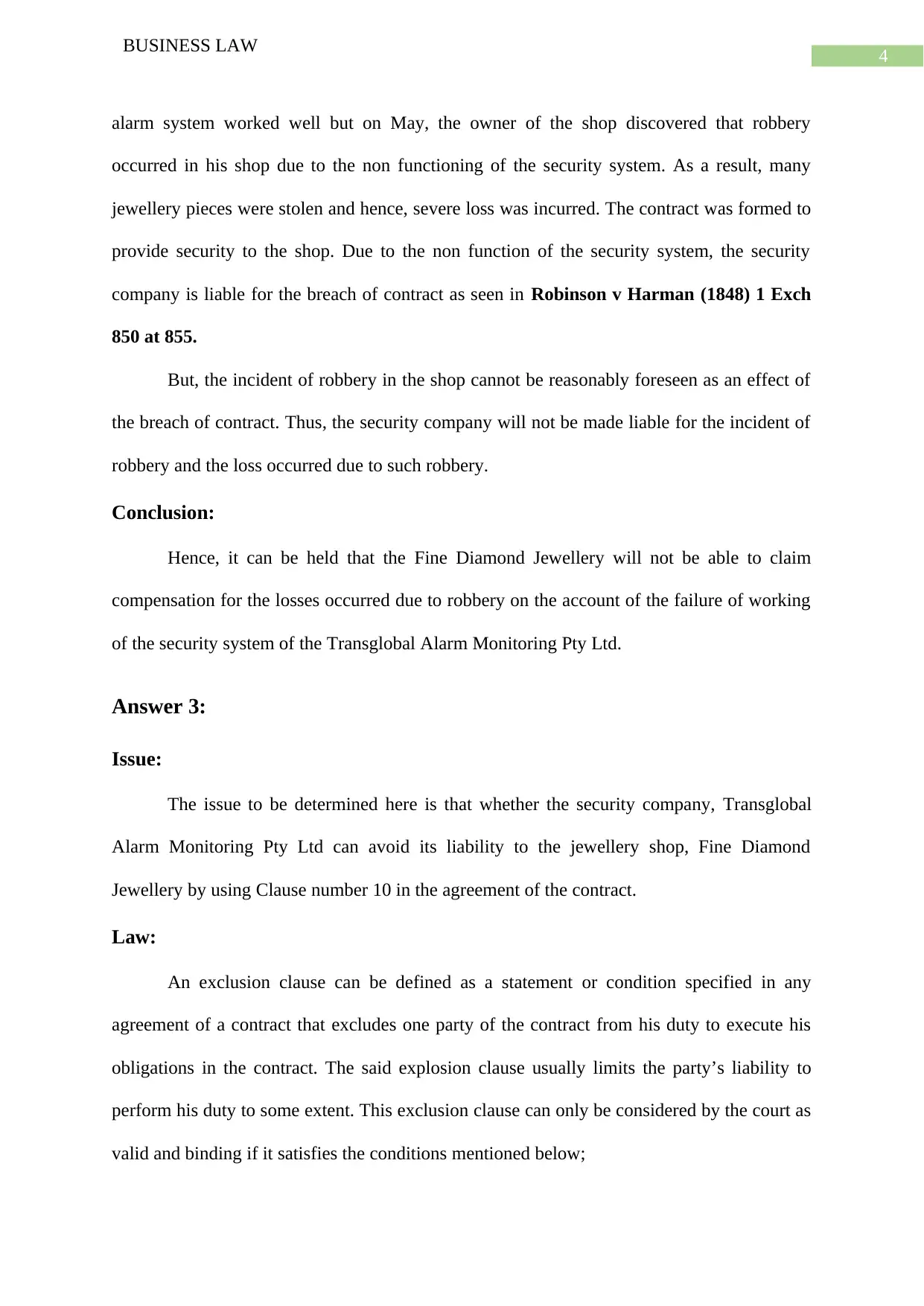
4
BUSINESS LAW
alarm system worked well but on May, the owner of the shop discovered that robbery
occurred in his shop due to the non functioning of the security system. As a result, many
jewellery pieces were stolen and hence, severe loss was incurred. The contract was formed to
provide security to the shop. Due to the non function of the security system, the security
company is liable for the breach of contract as seen in Robinson v Harman (1848) 1 Exch
850 at 855.
But, the incident of robbery in the shop cannot be reasonably foreseen as an effect of
the breach of contract. Thus, the security company will not be made liable for the incident of
robbery and the loss occurred due to such robbery.
Conclusion:
Hence, it can be held that the Fine Diamond Jewellery will not be able to claim
compensation for the losses occurred due to robbery on the account of the failure of working
of the security system of the Transglobal Alarm Monitoring Pty Ltd.
Answer 3:
Issue:
The issue to be determined here is that whether the security company, Transglobal
Alarm Monitoring Pty Ltd can avoid its liability to the jewellery shop, Fine Diamond
Jewellery by using Clause number 10 in the agreement of the contract.
Law:
An exclusion clause can be defined as a statement or condition specified in any
agreement of a contract that excludes one party of the contract from his duty to execute his
obligations in the contract. The said explosion clause usually limits the party’s liability to
perform his duty to some extent. This exclusion clause can only be considered by the court as
valid and binding if it satisfies the conditions mentioned below;
BUSINESS LAW
alarm system worked well but on May, the owner of the shop discovered that robbery
occurred in his shop due to the non functioning of the security system. As a result, many
jewellery pieces were stolen and hence, severe loss was incurred. The contract was formed to
provide security to the shop. Due to the non function of the security system, the security
company is liable for the breach of contract as seen in Robinson v Harman (1848) 1 Exch
850 at 855.
But, the incident of robbery in the shop cannot be reasonably foreseen as an effect of
the breach of contract. Thus, the security company will not be made liable for the incident of
robbery and the loss occurred due to such robbery.
Conclusion:
Hence, it can be held that the Fine Diamond Jewellery will not be able to claim
compensation for the losses occurred due to robbery on the account of the failure of working
of the security system of the Transglobal Alarm Monitoring Pty Ltd.
Answer 3:
Issue:
The issue to be determined here is that whether the security company, Transglobal
Alarm Monitoring Pty Ltd can avoid its liability to the jewellery shop, Fine Diamond
Jewellery by using Clause number 10 in the agreement of the contract.
Law:
An exclusion clause can be defined as a statement or condition specified in any
agreement of a contract that excludes one party of the contract from his duty to execute his
obligations in the contract. The said explosion clause usually limits the party’s liability to
perform his duty to some extent. This exclusion clause can only be considered by the court as
valid and binding if it satisfies the conditions mentioned below;
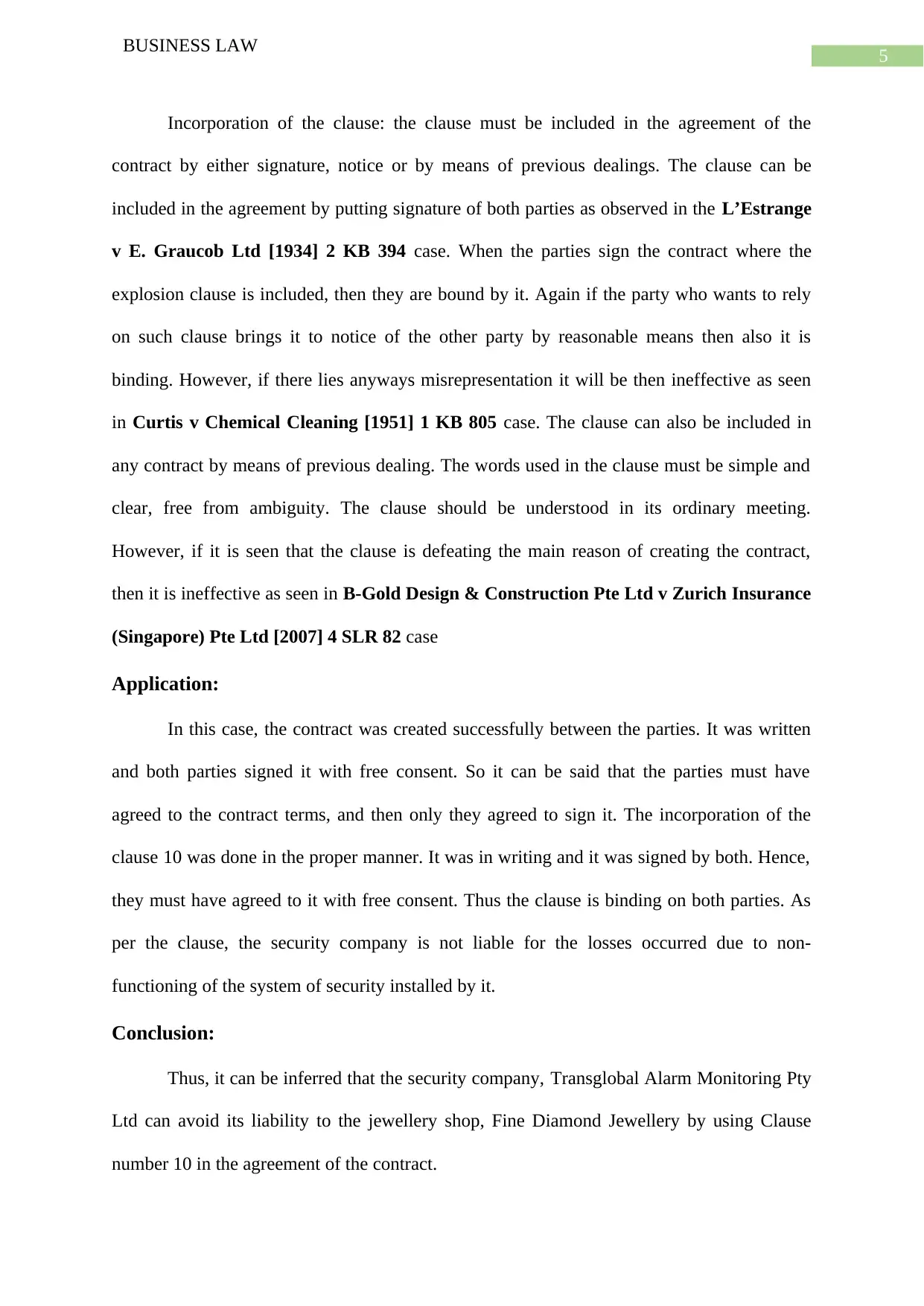
5
BUSINESS LAW
Incorporation of the clause: the clause must be included in the agreement of the
contract by either signature, notice or by means of previous dealings. The clause can be
included in the agreement by putting signature of both parties as observed in the L’Estrange
v E. Graucob Ltd [1934] 2 KB 394 case. When the parties sign the contract where the
explosion clause is included, then they are bound by it. Again if the party who wants to rely
on such clause brings it to notice of the other party by reasonable means then also it is
binding. However, if there lies anyways misrepresentation it will be then ineffective as seen
in Curtis v Chemical Cleaning [1951] 1 KB 805 case. The clause can also be included in
any contract by means of previous dealing. The words used in the clause must be simple and
clear, free from ambiguity. The clause should be understood in its ordinary meeting.
However, if it is seen that the clause is defeating the main reason of creating the contract,
then it is ineffective as seen in B-Gold Design & Construction Pte Ltd v Zurich Insurance
(Singapore) Pte Ltd [2007] 4 SLR 82 case
Application:
In this case, the contract was created successfully between the parties. It was written
and both parties signed it with free consent. So it can be said that the parties must have
agreed to the contract terms, and then only they agreed to sign it. The incorporation of the
clause 10 was done in the proper manner. It was in writing and it was signed by both. Hence,
they must have agreed to it with free consent. Thus the clause is binding on both parties. As
per the clause, the security company is not liable for the losses occurred due to non-
functioning of the system of security installed by it.
Conclusion:
Thus, it can be inferred that the security company, Transglobal Alarm Monitoring Pty
Ltd can avoid its liability to the jewellery shop, Fine Diamond Jewellery by using Clause
number 10 in the agreement of the contract.
BUSINESS LAW
Incorporation of the clause: the clause must be included in the agreement of the
contract by either signature, notice or by means of previous dealings. The clause can be
included in the agreement by putting signature of both parties as observed in the L’Estrange
v E. Graucob Ltd [1934] 2 KB 394 case. When the parties sign the contract where the
explosion clause is included, then they are bound by it. Again if the party who wants to rely
on such clause brings it to notice of the other party by reasonable means then also it is
binding. However, if there lies anyways misrepresentation it will be then ineffective as seen
in Curtis v Chemical Cleaning [1951] 1 KB 805 case. The clause can also be included in
any contract by means of previous dealing. The words used in the clause must be simple and
clear, free from ambiguity. The clause should be understood in its ordinary meeting.
However, if it is seen that the clause is defeating the main reason of creating the contract,
then it is ineffective as seen in B-Gold Design & Construction Pte Ltd v Zurich Insurance
(Singapore) Pte Ltd [2007] 4 SLR 82 case
Application:
In this case, the contract was created successfully between the parties. It was written
and both parties signed it with free consent. So it can be said that the parties must have
agreed to the contract terms, and then only they agreed to sign it. The incorporation of the
clause 10 was done in the proper manner. It was in writing and it was signed by both. Hence,
they must have agreed to it with free consent. Thus the clause is binding on both parties. As
per the clause, the security company is not liable for the losses occurred due to non-
functioning of the system of security installed by it.
Conclusion:
Thus, it can be inferred that the security company, Transglobal Alarm Monitoring Pty
Ltd can avoid its liability to the jewellery shop, Fine Diamond Jewellery by using Clause
number 10 in the agreement of the contract.
⊘ This is a preview!⊘
Do you want full access?
Subscribe today to unlock all pages.

Trusted by 1+ million students worldwide
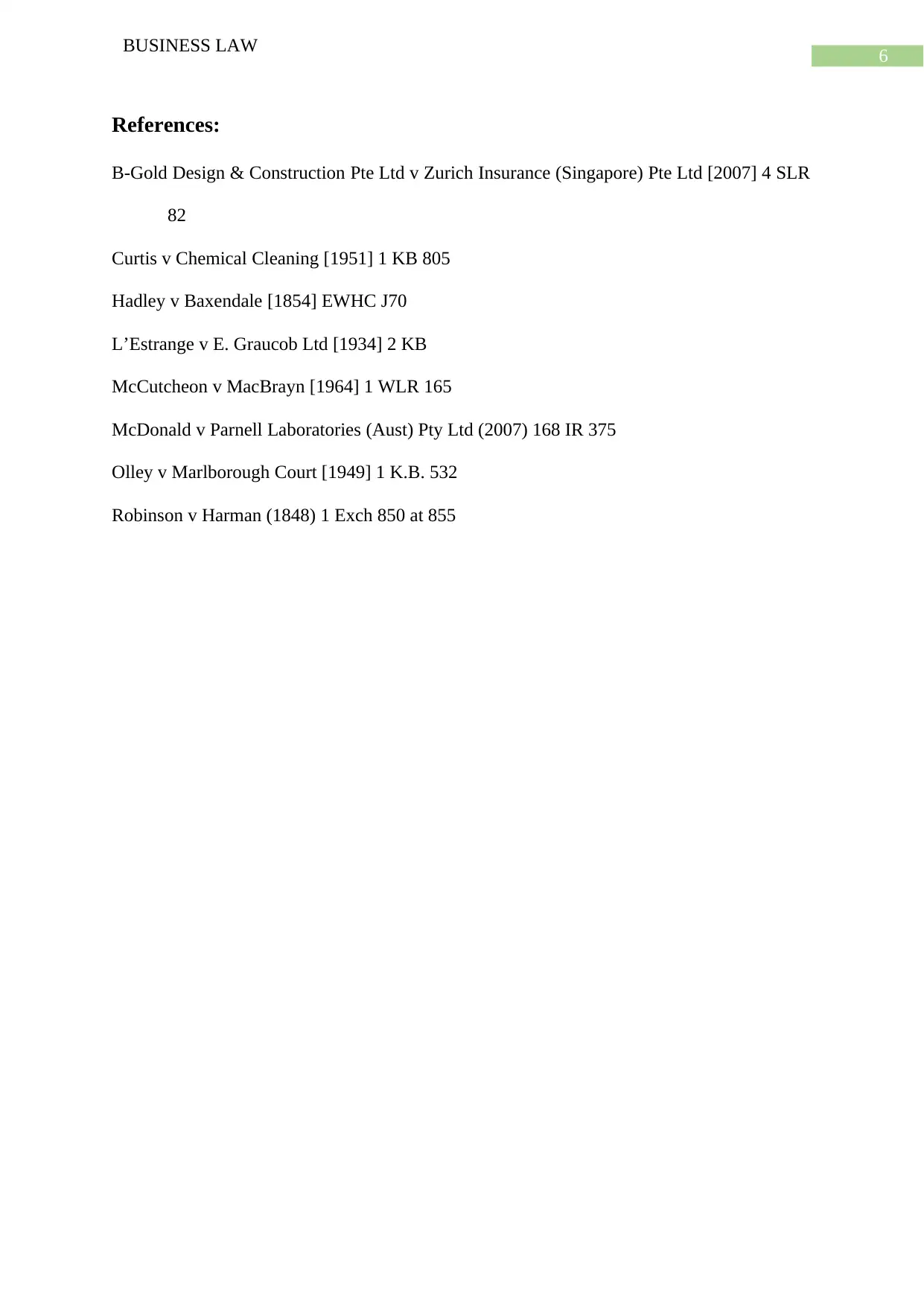
6
BUSINESS LAW
References:
B-Gold Design & Construction Pte Ltd v Zurich Insurance (Singapore) Pte Ltd [2007] 4 SLR
82
Curtis v Chemical Cleaning [1951] 1 KB 805
Hadley v Baxendale [1854] EWHC J70
L’Estrange v E. Graucob Ltd [1934] 2 KB
McCutcheon v MacBrayn [1964] 1 WLR 165
McDonald v Parnell Laboratories (Aust) Pty Ltd (2007) 168 IR 375
Olley v Marlborough Court [1949] 1 K.B. 532
Robinson v Harman (1848) 1 Exch 850 at 855
BUSINESS LAW
References:
B-Gold Design & Construction Pte Ltd v Zurich Insurance (Singapore) Pte Ltd [2007] 4 SLR
82
Curtis v Chemical Cleaning [1951] 1 KB 805
Hadley v Baxendale [1854] EWHC J70
L’Estrange v E. Graucob Ltd [1934] 2 KB
McCutcheon v MacBrayn [1964] 1 WLR 165
McDonald v Parnell Laboratories (Aust) Pty Ltd (2007) 168 IR 375
Olley v Marlborough Court [1949] 1 K.B. 532
Robinson v Harman (1848) 1 Exch 850 at 855
1 out of 7
Related Documents
Your All-in-One AI-Powered Toolkit for Academic Success.
+13062052269
info@desklib.com
Available 24*7 on WhatsApp / Email
![[object Object]](/_next/static/media/star-bottom.7253800d.svg)
Unlock your academic potential
Copyright © 2020–2025 A2Z Services. All Rights Reserved. Developed and managed by ZUCOL.




